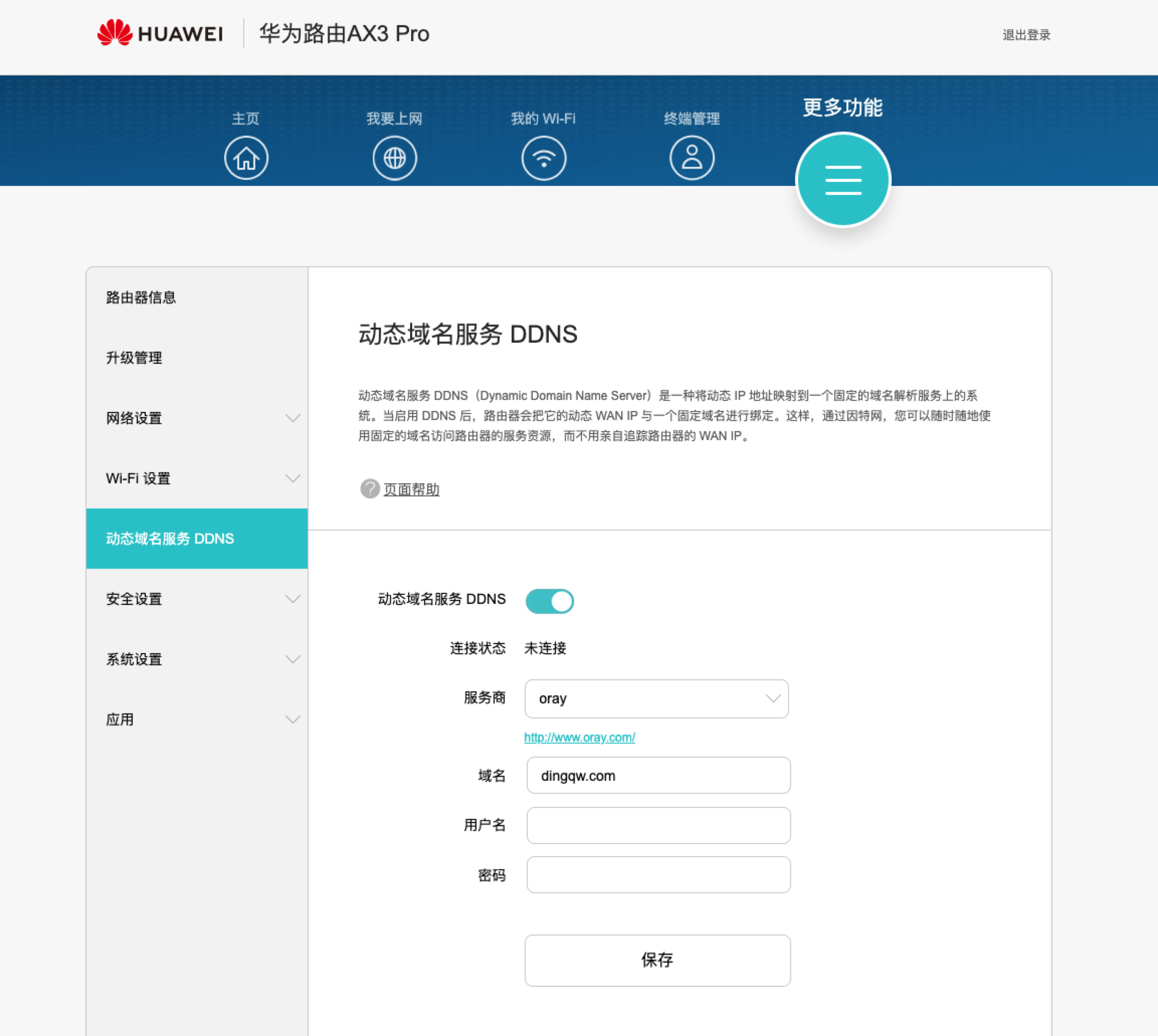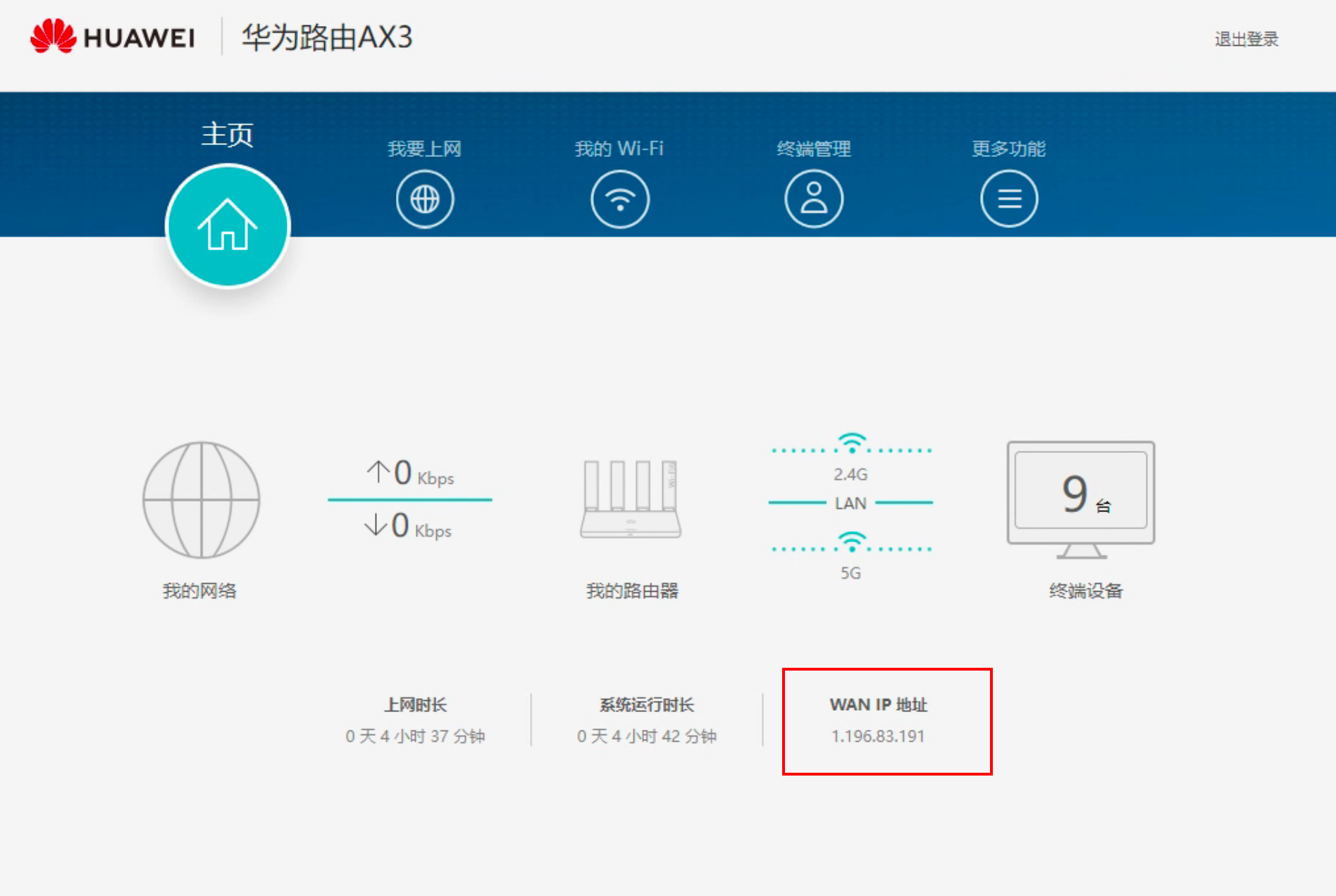自建服务器-阿里云动态域名绑定
背景
因为阿里云等云服务器资源过于贵,于是想到自己购买了一台华硕的台式机(6C12T16G)来部署自己的网站,但是需要解决以下问题:
- 停电来电后自动启动
- 公网IP-非固定IP
停电来电后自动启动
这个比较简单,只需要在BIOS设置下即可,每个电脑主板不一样,设置路径不一样,这里不做介绍, 或者也可以购买一个向日葵开机棒。
公网IP
这个需要与运营商打电话,让家里的宽带改为公网,如果能固定IP地址,则不用看以下步骤。 我这边是因为老家那边宽带不给改,需要拉专线,费用有点高,每隔一段时间,公网IP地址就变了,导致原来域名解析对应的IP变更, 无法访问服务器资源。
动态域名-方案1(不稳定)
通过路由器自带的动态域名服务DDNS,基本现在主流的路由器都支持

缺点是有时候公网IP已经变了很久,但是域名绑定的还是旧的IP地址,更新不及时。
动态域名-方案2
想到通过阿里云的相关接口,通过在自建服务器运行Python定时任务,获取当前公网IP地址,然后更新到阿里云的域名解析中,代码参考:
import time
import requests
# pip install aliyun-python-sdk-core
# pip install aliyun-python-sdk-alidns
from aliyunsdkcore.client import AcsClient
from aliyunsdkcore.request import CommonRequest
# 阿里云AccessKey
access_key_id = '************************'
access_key_secret = '************************'
rr = '@'
type = 'A'
# 登录域名列表页面,F12看接口返回查询到域名对应的记录ID dingqw.com
record_id = '86611287****3492096'
# 获取当前主机外网ip
def get_ip():
try:
# ipinfo.io/183.178.176.10?token=ce287aa5eedc81
# http://ifconfig.me/ip
response = requests.get('http://ifconfig.me/ip', timeout=8)
if response.status_code == 200:
# return json.loads(response.content.decode('utf-8').strip())['ip']
return response.content.decode('utf-8').strip()
print("无法获取外网IP地址", flush=True)
except Exception as e:
print(f'获取地址失败:{e}', flush=True)
return None
# 更新解析记录
def parse_ip(access_key_id, access_key_secret, record_id, rr, type, ip):
# 初始化阿里云API客户端
client = AcsClient(access_key_id, access_key_secret, 'cn-hangzhou')
# 更新解析记录
request = CommonRequest()
request.set_domain('alidns.aliyuncs.com')
request.set_version('2015-01-09')
request.set_action_name('UpdateDomainRecord')
request.add_query_param('RecordId', record_id)
request.add_query_param('RR', rr)
request.add_query_param('Type', type)
request.add_query_param('Value', ip)
try:
response = client.do_action_with_exception(request)
print(response.decode(), flush=True)
except Exception as e:
print(e, flush=True)
pass
# 获取公网IP地址
# ip = requests.get('http://ip.42.pl/raw').text
current_ip = get_ip()
print(f"本机外网 IP 地址为:{current_ip}", flush=True)
parse_ip(access_key_id, access_key_secret, record_id, rr, type, current_ip)
while True:
ip = get_ip()
if ip is not None and ip != current_ip:
print(f"有变更,IP地址为:{ip}", flush=True)
# 更新解析记录
parse_ip(access_key_id, access_key_secret, record_id, rr, type, ip)
current_ip = ip
time.sleep(10)
pythonw ddns.py
缺点就是因为查询当前电脑主机外网IP时,都是调用的第三方服务接口,即不稳定,有时候这个接口可能会屏蔽掉, 无法使用等情况。
升级方案
突然想到路由器是有获取外网IP地址的,作者用的路由器型号为:华为AX3,看下图

我们只需要获取到以上返回的WAN IP地址即可,打开F12,发现调用接口如:http://192.168.3.1/api/ntwk/wandetect,返回如下数据
{
"ID": "InternetGatewayDevice.WANDevice.1.WANConnectionDevice.1.WANPPPConnection.1.",
"IPv6ConnectionStatus": "Connected",
"AutoFlag": "0",
"BackupStatus": 1,
"PVCResult": "",
"Uptime": 16778,
"IPv6PrefixLength": 64,
"ConnectionStatus": "Connected",
"ExternalIPAddress": "1.196.83.191",
"HttpStatus": 2,
"AccessPortCount": 4,
"ConnectionType": "PPP_Routed",
"DefaultGateway": "1.196.83.254",
"IPv6Address": "240e:33c:7900:3d09:81eb:faf7:1498:3b43\/64",
"ErrReason": "Success",
"IPv6PrefixList": "240e:33d:7913:2000::\/64",
"IPv6Enable": true,
"Status": "Connected",
...
}
而以上ExternalIPAddress就是我们想要的值,如何调用此接口呢,直接调用肯定不能通过,因为需要登录验证。费了一番功夫,才获取到登录会话信息,安全也是没谁了,参考如下Python代码:
import random
import json
import hashlib
import hmac
import requests
class HWRouter:
def __init__(self, url, username, password):
self.cookie = None
self.url = url
self.username = username
self.password = password
def init(self):
response = requests.get(self.url + "/html/index.html")
if response.status_code == 200:
res_data = response.text
csrf_param_start = res_data.find("csrf_param")
res_data = res_data[csrf_param_start:]
csrf_param_start = res_data.find("=\"") + 2
csrf_param_end = res_data.find("\"/>")
csrf_param = res_data[csrf_param_start:csrf_param_end].strip()
csrf_token_start = res_data.find("csrf_token")
res_data = res_data[csrf_token_start:]
csrf_token_start = res_data.find("=\"") + 2
csrf_token_end = res_data.find("\"/>")
csrf_token = res_data[csrf_token_start:csrf_token_end].strip()
cookie_path = response.headers.get("Set-Cookie")
cookie_split = cookie_path.index(";")
self.cookie = cookie_path[:cookie_split]
return csrf_param, csrf_token
else:
return False
def login(self):
csrf_param, csrf_token = self.init()
first_nonce = self.random_nonce()
login_nonce = self.user_login_nonce(first_nonce, csrf_param, csrf_token)
if login_nonce is None:
return False
iterations = login_nonce.get('iterations')
salt = login_nonce.get('salt')
server_nonce = login_nonce.get('servernonce')
csrf_token = login_nonce.get('csrf_token')
csrf_param = login_nonce.get('csrf_param')
salted_password = self.get_salted_password(self.password, self.hex_to_byte_array(salt), iterations)
client_key = self.get_hmac("Client Key", salted_password)
store_key = self.get_store_key(client_key)
auth_msg = first_nonce + "," + server_nonce + "," + server_nonce
client_signature = self.get_hmac(auth_msg, store_key)
new_arr = [0] * len(client_key)
for i in range(len(client_key)):
new_arr[i] = client_key[i] ^ client_signature[i]
client_proof = self.bytes_to_hex(new_arr)
login = {"data": {"clientproof": client_proof,
"finalnonce": server_nonce},
"csrf": {"csrf_param": csrf_param,
"csrf_token": csrf_token}}
headers = {
"Cookie": self.cookie,
"Content-Type": "application/json"
}
response = requests.post(self.url + "/api/system/user_login_proof", headers=headers,
data=json.dumps(login))
self.cookie = response.headers["Set-Cookie"]
return True
def user_login_nonce(self, first_nonce, csrf_param, csrf_token):
headers = {
"Cookie": self.cookie,
"Content-Type": "application/json"
}
payload = {
"csrf": {
"csrf_param": csrf_param,
"csrf_token": csrf_token
},
"data": {
"firstnonce": first_nonce,
"username": self.username
}
}
response = requests.post(self.url + "/api/system/user_login_nonce", headers=headers, data=json.dumps(payload))
if response.status_code == 200:
reps_json = response.json()
if "Set-Cookie" in response.headers:
self.cookie = response.headers["Set-Cookie"]
return reps_json
return None
def get_salted_password(self, password, salt, iterations):
salted_password = hashlib.pbkdf2_hmac('sha256', password.encode('utf-8'), salt, iterations, dklen=32)
return salted_password
def get_hmac(self, key, input_data):
hmac_obj = hmac.new(key.encode('ascii'), input_data, hashlib.sha256)
return hmac_obj.digest()
def get_store_key(self, client_key):
store_key = hashlib.sha256(client_key).digest()
return store_key
def hex_to_byte_array(self, in_hex):
hex_length = len(in_hex)
result = bytearray()
if hex_length % 2 == 1:
hex_length += 1
in_hex = "0" + in_hex
for i in range(0, hex_length, 2):
result.append(int(in_hex[i:i + 2], 16))
return result
def bytes_to_hex(self, bytes):
return ''.join(['{:02x}'.format(byte) for byte in bytes])
def random_nonce(self):
rand = "abcdef1234567890"
sb = []
for i in range(64):
number = random.randint(0, len(rand) - 1)
sb.append(rand[number])
return ''.join(sb)
def get(self, url):
headers = {"Cookie": self.cookie}
response = requests.get(self.url + url, headers=headers)
if response.status_code == 200:
body = response.json()
new_header = response.headers.get("Set-Cookie")
if new_header:
self.cookie = new_header
return body
else:
return None
if __name__ == "__main__":
# 默认
url = "http://192.168.3.1"
# 默认,用户名不用动
username = "admin"
# 改为自己路由器的密码
password = "******"
m = HWRouter(url, username, password)
if m.login():
# 获得主机
data = m.get("/api/ntwk/wandetect")
externalIPAddress = data.get("ExternalIPAddress")
print("ExternalIPAddress : " + externalIPAddress)
直接修改下以上代码password,其他不用动,基本都是通用的,直接运行即可获取到外网IP地址。 最后开始的ddns.py文件,get_ip()修改下即可。
